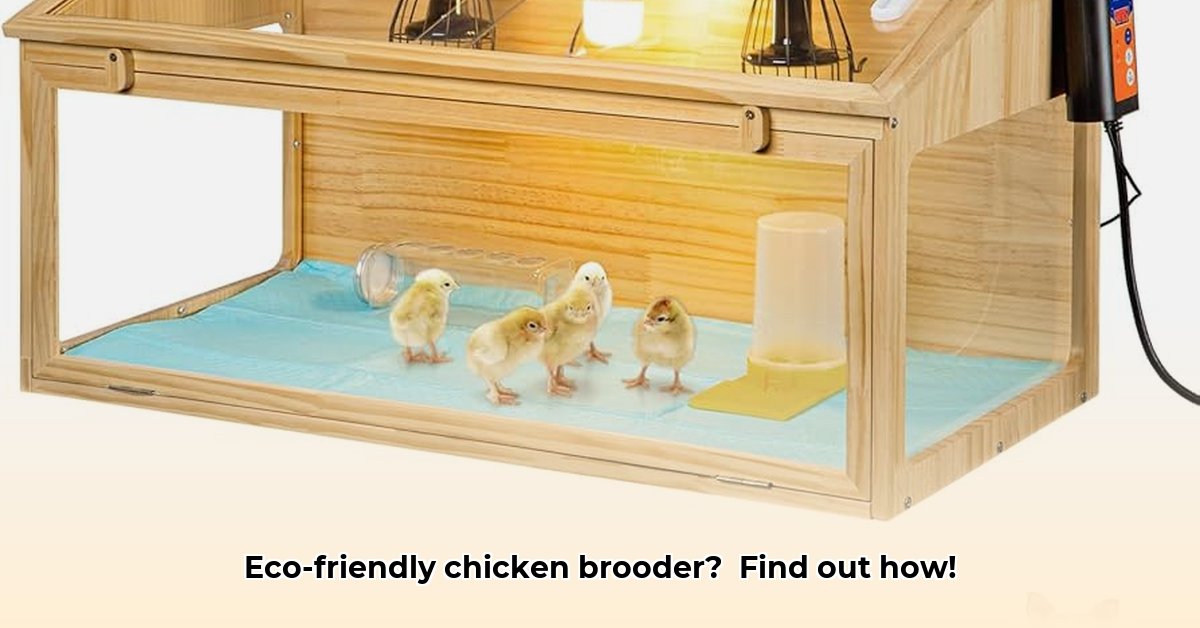
Choosing Your Chick Brooder Setup at Tractor Supply
Raising chicks sustainably starts with the right brooder. Tractor Supply offers various options catering to different needs and budgets. Let's explore your choices:
Heat Lamps: Affordable and readily available, but require careful use to prevent fire hazards. Always use a protective lamp guard and maintain safe distances. Never leave unattended.
Brooder Plates: These provide more consistent heat, enhancing safety compared to heat lamps. The higher initial cost is often offset by increased reliability and reduced risk.
Pre-Assembled Brooders: Convenient and ready-to-use, although customization options might be limited. Tractor Supply stocks various sizes and features to suit different flock sizes and spaces.
Choosing the right brooder size is crucial. Overcrowding stresses chicks, impacting health and growth. Consider your chick numbers and available space carefully. A spacious brooder allows chicks to move freely, promoting comfort and minimizing stress. Isn't it important to give your chicks the space they need to flourish? A roomy brooder leads to healthier, happier birds. For more info on Tractor Supply brooders, check out this helpful resource.
Setting Up Your Tractor Supply Brooder: A Step-by-Step Guide
Creating an optimal brooding environment is simple with these steps:
Sanitize Thoroughly: Before adding bedding, thoroughly clean the brooder. This prevents the spread of diseases, ensuring a healthy start for your chicks.
Select Appropriate Bedding: Opt for absorbent bedding like pine shavings or recycled paper. Avoid cedar shavings, which can harm chicks. A dry environment is vital for chick health.
Strategic Heat Source Placement: Position your heat source to allow chicks to regulate their body temperature by moving closer or farther away. Remember, young chicks lack effective thermoregulation.
Precise Temperature Monitoring: Use a reliable thermometer. Aim for 95°F (35°C) the first week, gradually decreasing by 5°F (3°C) weekly. Consistent monitoring is key to chick health.
Essential Food and Water: Provide fresh food and water daily using feeders and waterers designed to minimize spills and maintain a dry environment. Multiple waterers reduce competition, ensuring all chicks stay hydrated. Did you know that consistent access to clean water is crucial for chick health and growth?
Beyond the Brooder: Essential Supplies for Healthy Chicks
Essential supplies complement your brooder setup:
Reliable Thermometer: Accurate temperature monitoring is vital for chick well-being.
Clean Water Source: Fresh, clean water is essential. Multiple waterers reduce competition and ensure hydration.
High-Quality Chick Starter Feed: A quality chick starter feed provides the necessary nutrients for healthy growth.
Regular Bedding Changes: Frequent bedding changes maintain a dry, sanitary environment, preventing disease.
Sustainable Brooding: Eco-Friendly Choices
Sustainable brooding minimizes your environmental impact:
Energy-Efficient Heating: Opt for energy-efficient heating options, like LED grow lights over incandescent bulbs. This reduces your carbon footprint.
Waste Reduction: Use recycled materials for bedding and supplies whenever possible. Compost used bedding to reduce waste and create valuable garden fertilizer.
Support Local Businesses: Source supplies locally to reduce transportation emissions and support your community.
Weighing the Pros and Cons of Tractor Supply for Brooding Supplies
| Pros | Cons |
|---|---|
| Convenient location and readily available supplies | Selection may be limited compared to online retailers |
| Competitive pricing | Quality variations may exist among brands |
| Wide variety of brooding options and sizes | Some items may require assembly |
Remember, raising healthy chicks requires care and attention. A well-equipped brooder from Tractor Supply, combined with sustainable practices, significantly improves your chances of success. Remember that while these suggestions are generally sound, every flock is unique, and you may need to adjust to specific needs.
How to Reduce Energy Consumption in Sustainable Poultry Brooding Systems
Reducing energy consumption in your brooding setup is crucial for both cost savings and environmental responsibility. Let's explore effective strategies:
Choosing the Right Brooder
Energy efficiency begins with careful brooder selection:
Appropriate Sizing: Choose a brooder sized correctly for your flock. Oversized brooders waste energy heating unnecessary space.
Superior Insulation: Robust insulation minimizes heat loss. Look for brooders with thick walls and a well-insulated lid.
Efficient Heat Source: While infrared heat lamps are common, they can be energy-intensive. Consider heat plates or low-wattage lamps or even explore passive solar heating options.
Optimizing Brooder Placement
Strategic placement minimizes energy use and maximizes natural resources:
Maximize Sunlight: Position the brooder near a south-facing window (Northern Hemisphere) to harness free supplemental heat.
Avoid Drafts: Shield the brooder from drafts and air leaks which cause significant heat loss.
Monitor Temperature: Regularly monitor the brooder temperature using an accurate thermometer. Adjust the heat source as needed to maintain the optimal temperature range.
Energy-Saving Brooder Management Techniques
Implementing these techniques significantly reduces energy consumption:
Balanced Ventilation: Proper ventilation prevents ammonia buildup and excess moisture while minimizing heat loss.
Precise Temperature Control: Maintain the appropriate temperature range for your chicks' age, avoiding overheating which wastes energy.
Alternative Heat Sources: Explore using passive solar heat or even a warm water bottle wrapped in towels as supplementary heat sources.
Regular Cleaning: Regular cleaning improves heat distribution. Dirty brooders impede heat transfer efficiently and result in higher energy consumption.
Sustainable Brooder Materials
Using eco-friendly materials in brooder construction or modification enhances sustainability:
Recycled Insulation: Use recycled materials like cardboard or old blankets for insulation. This is both cost-effective and environmentally conscious.
Heat-Absorbing Materials: Employ dark-colored materials inside your brooder to maximize heat absorption from sunlight or other sources.
Consistent Monitoring and Adjustment
Continuously monitor temperature and humidity levels, making adjustments as needed. This is particularly essential during fluctuating weather conditions. Consistent monitoring leads to energy efficiency and less stress for both you and your chicks.